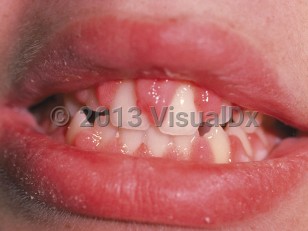Gingival enlargement may result from reactive gingival overgrowth or infiltrative processes.
Gingival overgrowth:
- Plaque induced – The most common cause of gingival overgrowth is poor oral hygiene. The gingiva may become enlarged and edematous as a result of plaque-induced inflammation, an extension of common gingivitis.
- Hormonal – Hormonal alterations, such as during puberty and pregnancy, can exacerbate gingival inflammation.
- Drug induced – Medications including anticonvulsants (such as phenytoin), immunosuppressants (such as cyclosporine), and calcium channel blockers (such as nifedipine and diltiazem) are further culprits. The mechanism by which these drugs induce gingival enlargement is not fully understood, but fibroblastic proliferation has been suggested. Drug-induced gingival enlargement typically affects the anterior gingiva and usually occurs within 3 months of starting the medication. It occurs in 25%-50% of patients taking these medications. This affects patients with seizure disorders who are prescribed anticonvulsant medications (generally younger patients and adults) and those who have undergone organ transplantation and are on immunosuppressant medications, in particular renal transplantation (generally adults). Although poor oral hygiene plays an important role in drug-induced gingival enlargement, the variable severity in affected individuals likely indicates a genetic predisposition.
- Vitamin C deficiency – This commonly presents with gingival enlargement with increased friability.
- Granulomatous cheilitis – Can present with gingival enlargement that, on biopsy, contains nonnecrotizing granulomas. There is usually a history of and/or concomitant lip and facial swelling. Fissured tongue may also be present in the variant Melkersson-Rosenthal syndrome.
- Oral leukemic infiltration – This is particularly prone to involve the gingiva, although other forms of leukemia may also do so. The gingiva is usually friable, soft, boggy, and erythematous and bleeds readily.
- Kaposi sarcoma – Involves the gingiva and palatal tissues and has a purplish, dusky-red appearance.
- Granulomatosis with polyangiitis – The gingiva has a pebbly, erythematous appearance, the so-called "strawberry gingivitis." Serologic markers for perinuclear antineutrophil cytoplasmic antibodies (p-ANCA) and cytoplasmic ANCA (c-ANCA) are often positive.
- Hereditary gingival fibromatosis – Usually present in childhood with a family history of this disorder. The gingiva is usually pink and fibrotic.
- Juvenile hyaline fibromatosis – An inherited disorder that can cause gingival enlargement. There are usually concomitant nodular skin lesions.
- Ligneous conjunctivitis – This is a rare inherited disorder of plasminogen deficiency leading to masses of granulation tissue on the gingiva containing fibrin.



